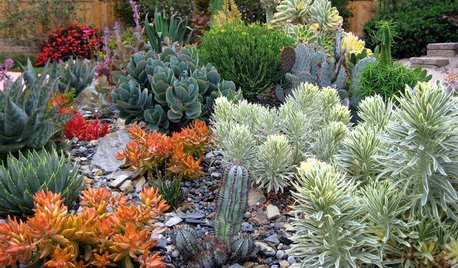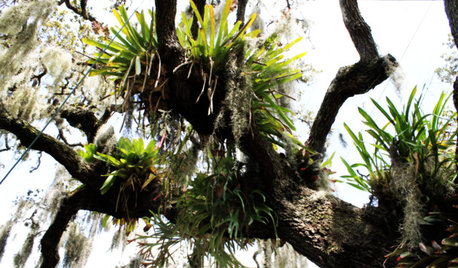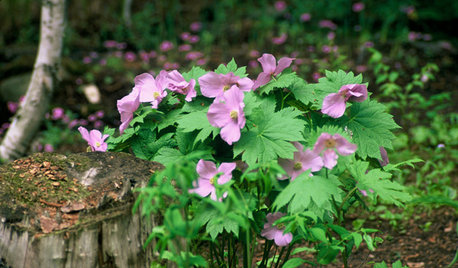Moss FAQS: Propagation
Moss must continually make more leaves, stems, rhizoids, etc or its growth cycle stagnates and ends. Moss can be propagated from all of the above moss plant parts as well as spores. This FAQ will not cover propagation from spores.
Moss Collection and Propagation example
I was at my motherÂs house yesterday and while walking I found a tiny light green moss growing in a patch three inches square. Suppose I wanted to grow that moss to cover a few square feet how would I proceed? Suppose I wanted to grow that moss to cover a hundred square feet how would I proceed? The following example is for moss found growing on soil. NOT moss found growing on logs or trees and NOT moss found growing on rocks. Those type of mosses will be covered also in different FAQs. Ninety percent of all mosses grow on some type of soil.
The first steps which are the easiest are also the most critical.
1. What type of soil is the moss growing on? In this case the soil was actually a common light brown clay soil.
2. Next, what were the light conditions in which it was growing? The moss was growing in the yard about three feet from the side of the garage. But although I was for many years a Boy Scout and Girl Scout Leader I am not good with directions, and I would need to know which side of the house this moss was growing on; the North, East, South or West side. So I would go to Mapquest and looking up momÂs address and I find that the moss was growing on the West side.
3. Next, how much shade does this moss get in the day from buildings and trees. Since the sun rises in the East this moss gets shade from the garage until the sun is directly overhead and then for about an hour or two in the summer this moss gets hot sun. Then as the sun moves to the West the neighborÂs house shades the moss. So this moss likes shade but will tolerate some direct sun.
So the moss I observed was healthy, grows on clay soil which is not acidic but rather alkaline in pH, and likes shade but can tolerate sun for a few hours.
4. This example moss was tiny so I would use a spatula to scoop up the moss with a
little of the soil attached.
Since the moss sample is small I would suggest growing the moss in a saucer or tray until larger. The saucer or tray should not have any drainage holes in the bottom. After a rain I would just dump out the extra water just until the moss was up out of the water. I usually raise one end of the tray so that the water runs to the other end and the moss is just up out of the water. As the moss dries out over the next couple of days I lower the moss end of the tray until the moss gets some of the water that is at the other end of the tray. Fertilize? Not yet. Whatever light conditions I determined the moss was growing in the "wild" I note but, for the start of the propagation I keep the moss in slightly dimmer light conditions. DonÂt put the moss in the dark, just in an area that gets a little less light that where you found it.
The moss is getting rain supplemented with collected rainwater or if unavailable then distilled water. Supplemented water is applied with a sprayer. The moss is not kept drenched but is allowed to dry out every three to four days. The moss is not getting too much light. These conditions and temperature above forty degrees Fahrenheit and the moss should grow.
I next observe the moss every day or two. Generally moss when hydrated has a nice sheen or green luster. Observation will tell me things about the moss. Some moss when it starts growing will have light yellow green tips. Some moss will have the leaves get bigger and really plump up before new shoots develop. Any browning or discoloration indicates too much sun or possibly too much water. After anywhere from one to two months the moss is ready to move to the next propagation stage.
Up till now the moss is still pretty much just a larger clump of what was found in the "wild". We now have four different ways to proceed.
A. Take some of the moss and go to moss slurry and continue in trays.
B. Divide the moss into smaller clumps or fragments and continue to grow in trays.
C. Put the moss in the landscape
D. Or just grow the moss in a small container or bonsai.
A. Moss slurries
Ingredients: water or other liquid, moss and thickener.
Water; distilled or rainwater. Other liquids used have been beer.
Moss and thickener; the thickener used has been water retention gel or
buttermilk, or clay soil, or black soil.
This site explains slurries and planting moss fragments
http://bryophytes.science.oregonstate.edu/page32.htm
This site is mossacres and they recommend using water retention gel
http://www.mossacres.com/info_5.asp#7
Rinse the moss in water to remove any dirt and algae and other detritus.
All slurries are blended in a blender for a few minutes till the consistency of pancake batter. It is not necessary but if you wish you can place half an inch of soil in the bottom of the potting tray similar to the soil the moss was growing on in the "wild". To facilitate transplanting the moss later, place some fine netting in the bottom of the tray (and on top of the soil is using soil). Spread the slurry on the bottom of the potting tray. Schenk recommends using cheesecloth but fine plastic netting in the fabric section of WalMart is cheaper and has smaller openings. This netting is like a $1 per running yard and the width of the netting is 54 inches. Moss slurries disrupt the moss growing cycle and cause it to revert to more primitive methods of propagation. Leaf and stem fragments will generate green threadlike moss protonema which will eventually grow into moss plants. Also, growing on the leaf surfaces and attached to the stems of most mosses are "seed like" capsules called gemmae. These are clone capsules of the plant. Pulverizing moss in a blender causes these gemmae to "sprout" and develop the protonema algal-like threads which over a few weeks to months will become moss plants. Keep this tray lightly misted once to twice per day in between rains. DonÂt let this tray get flooded with rainwater.
For B and C; propagating small clumps in trays or in the landscape consider the Law of Moss Clump Edges. Moss grows as a clump with hundreds or thousands of little moss plants in the clump. The moss plants on the outer edge of the clump dry out quicker than the moss plants that are not on the outside edge. If you want to have your moss spread, the edges must be sprayed more often than the center or the clump edge must be pushed down into the soil more so it is not as exposed to wind. We have all seen moss clumps that raise up in the center. The center moss plants have continued growing while the outside plants have not grown as much.
B. The moss growing in the tray is divided into smaller fragments or clumps. To facilitate these fragments growing together spread a thin layer of soil or sand or mixture of the two in the bottom of the tray. Whatever you spread on the bottom of the tray should be similar to what the moss was found growing on in nature. Place some netting as mentioned above onto the surface of this soil and then firmly compress the moss fragments, no smaller than three inch diameter in size, onto the netting/soil. Keep watered between rains but periodically every three to four days let the moss dry out a little. The moss should always feel at least slightly damp when it has slightly dried out. The moss should never become dry as paper.
C. Moss in the landscape is the same as B except the location must be suitable for shade and the soil must be also be compatible. Moss generally needs lots of shade. Moss in the landscape doesnÂt have the high humidity of the potting trays or the woods. Growth will be slower. Daily watering as needed will promote growth. Use a garden sprayer with collected rainwater (filtered through a cloth to prevent the sprayer from plugging up) or use distilled water. Do not water with a watering can unless you have lots of water. The moss leaves when dehydrated can take a few minutes to fully expand and soak up the water. I spray the moss foliage, then come back a few minutes later and spray again. A gallon of water can keep five square feet of moss fully hydrated for a month. Plan on daily misting as necessary for a couple months at least to promote growth. The soil needs to be similar to what the moss was growing on in nature. Read Moss FAQS: Moss on Soil or Other Surfaces to understand how to make your soil compatible with your moss.
D. Moss in small containers. Most gardeners have container plants both indoors and outdoors. Moss does well in containers. Moss can be a groundcover in a container with other plants or moss can be the center of interest in the container. Regular misting will keep the humidity up and encourage growth.
Fertilize with an acid type fertilizer at one quarter the recommended strength every three weeks. Use Acid fertilizer like Peters or Miracid or Miracle Gro for acid loving plants and not regular fertilizers which can have calcium and zinc as ingredients both of which are death to mosses.
Notes:
This is an eight inch clay saucer with no drain holes and no soil. The mosses are Dicranum flagellare on the left and another Dicranum of a different species on the right. These mosses have received no fertilizer over the last four months and have been on the north side of the house close to the building with only occasional rainwater. I tip out excess rainwater in the clay saucer as needed. Regular clay saucers are very porous surfaces and thus not as good for propagating mosses as plastic potting trays.
http://i61.photobucket.com/albums/h65/deep_woods/Propagation/HPIM0861.jpg
These two potting trays are examples of moss propagation. The moss in the left clear tray was placed in this tray two weeks ago. Before that this moss was getting a lot of shade and almost no water in its location under a raised deck. If you click on the picture you can see the moss which two weeks ago was a dull dark green is covered by new light green growth at the tips of the moss stems. I did fertilize once a week ago. The moss in the black plastic tray on the right was growing in sand up till two months ago. The moss was almost lifeless and a shriveled up brownish green. In this two month period the moss has almost tripled in size and definitely looks a lot better.
http://i61.photobucket.com/albums/h65/deep_woods/Propagation/HPIM0859.jpg
Notes on sand and drainage holes.
I have found that sand as a growing medium is almost useless unless the moss is watered daily. Otherwise the sand wicks the moisture away from the moss, causing the moss to dehydrate quickly. Think of a golf course putting green. Underneath the putting grass is several inches of sand. The putting greens are watered every day to keep the grass growing. If you live in an area of the country that receives frequent rains then moss will grow on sand. However if you have sand as the growing medium and there are no drainage holes then sand is great.
Drainage holes in the bottom of the tray allow the pot or tray to rid itself of excessive moisture. If you donÂt have drainage holes then the moss can become submerged after a big rain and if left untended for several days the moss dies. So saucers with drainage holes drain the water away from the moss. Moss of course has no roots to store water and moss leaves are usually only one cell thick. So frequent mistings/sprayings are then necessary to rapidly grow moss.
One alternative is to consider drilling a drainage hole in the side of the saucer up from the bottom one quarter to one inch (depending on the container). Moss generally does well growing on wet surfaces as long as the moss itself is not submerged. Consider the widespread use of self watering pots that have a reservoir for water in the saucer and a wick to move water by capillary action up to the potting soil. Moss can act as its own wick.
Rick
















Chrystal Jumonville